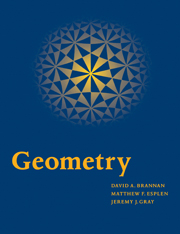Book contents
- Frontmatter
- Contents
- preface
- Introduction: Geometry and Geometries
- 1 Conics
- 2 Affine Geometry
- 3 Projective Geometry: Lines
- 4 Projective Geometry: conics
- 5 Inversive Geometry
- 6 Non-Euclidean Geometry
- 7 Spherical Geometry
- 8 The Kleinian View of Geometry
- Appendix 1 A Primer of Group Theory
- Appendix 2 A Primer of Vectors and Vector Spaces
- Appendix 3 Solutions to the Problems
- Index
8 - The Kleinian View of Geometry
Published online by Cambridge University Press: 05 June 2012
- Frontmatter
- Contents
- preface
- Introduction: Geometry and Geometries
- 1 Conics
- 2 Affine Geometry
- 3 Projective Geometry: Lines
- 4 Projective Geometry: conics
- 5 Inversive Geometry
- 6 Non-Euclidean Geometry
- 7 Spherical Geometry
- 8 The Kleinian View of Geometry
- Appendix 1 A Primer of Group Theory
- Appendix 2 A Primer of Vectors and Vector Spaces
- Appendix 3 Solutions to the Problems
- Index
Summary
We now describe in detail what we have called the Kleinian view of geometry. As we said earlier, this is a powerful way in which the geometries we have presented can be unified and seen as different aspects of the same idea.
Chapter 0
Affine Geometry
Klein argued that in any geometry there are properties of figures that one discusses, but these properties vary from one geometry to another. In Euclidean geometry, segments have lengths, lines cross at angles one can measure; it makes sense to ask if a given triangle is equilateral, and so on. But none of these properties makes sense in affine geometry. There one may speak only of ratios of lengths along parallel lines, and all triangles are (affine) congruent. Klein interpreted this as follows: in each geometry we are studying the same space of points, the familiar plane ℝ2. In Euclidean geometry we admit only the transformations that preserve length. These are transformations of the form
We shall consider only plane geometries for the moment.
t(x) = Ux + a,
where U is an orthogonal 2 × 2 matrix and a ∈ ℝ2.
Because every transformation in Euclidean geometry preserves lengths, and therefore angles, it makes sense to speak of distance in this geometry.
In affine geometry, however, we admit all transformations of the form
t(x) = Ax + b,
where A is an invertible 2 × 2 matrix and b ∈ ℝ2. Because every transformation in affine geometry preserves ratios of lengths along parallel lines, it makes sense to speak of such ratios in this geometry.
- Type
- Chapter
- Information
- Geometry , pp. 360 - 374Publisher: Cambridge University PressPrint publication year: 1999

